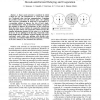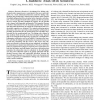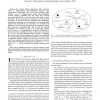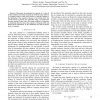CORR
2007
Springer
13 years 4 months ago
2007
Springer
— A linear mesh network is considered in which a single user per cell communicates to a local base station via a dedicated relay (two-hop communication). Exploiting the possibly ...
CORR
2007
Springer
13 years 4 months ago
2007
Springer
Synchronization of relay nodes is an important and critical issue in exploiting cooperative diversity in wireless networks. In this paper, two asynchronous cooperative diversity s...
CORR
2007
Springer
13 years 4 months ago
2007
Springer
—Resource allocation is investigated for fading relay channels under separate power constraints at the source and relay nodes. As a basic information-theoretic model for fading r...
CORR
2007
Springer
13 years 4 months ago
2007
Springer
A multiple input multiple output (MIMO) two-way relay channel is considered, where two sources want to exchange messages with each other using multiple relay nodes, and both the s...
CORR
2007
Springer
13 years 4 months ago
2007
Springer
Abstract— We analyze fading relay networks, where a singleantenna source-destination terminal pair communicates through a set of half-duplex single-antenna relays using a two-hop...
CORR
2007
Springer
13 years 4 months ago
2007
Springer
—We analyze fading interference relay networks where M single-antenna source-destination terminal pairs communicate concurrently and in the same frequency band through a set of K...
CORR
2007
Springer
13 years 4 months ago
2007
Springer
—This paper characterizes the capacity of a class of modulo additive noise relay channels, in which the relay observes a corrupted version of the noise and has a separate channel...
CORR
2007
Springer
13 years 4 months ago
2007
Springer
— The problem of resource allocation is studied for a two-user fading orthogonal multiaccess relay channel (MARC) where both users (sources) communicate with a destination in the...
CORR
2007
Springer
13 years 4 months ago
2007
Springer
— We consider a dense fading multi-user network with multiple active multi-antenna source-destination pair terminals communicating simultaneously through a large common set of K ...
CN
2007
13 years 4 months ago
2007
— We consider a mobile ad hoc network consisting of three types of nodes: source, destination, and relay nodes. All the nodes are moving over a bounded region with possibly diffe...




